Critical Analysis of the Fair Work Act 2009: Employee Rights
VerifiedAdded on 2023/06/10
|5
|1534
|328
Essay
AI Summary
This essay provides a critical discussion of the Fair Work Act 2009, focusing on its provisions for employee protection against unfair dismissal. The introduction outlines the Act's role in regulating employment and workplace relations, emphasizing its objectives of establishing fair workplace terms, a safety net, and maintaining a balance between work and personal life. The essay then delves into the key features of the unfair dismissal provisions, detailing the circumstances under which a dismissal is considered unfair. It highlights the promotion of fairness, efficiency, flexibility, and employment security, while also acknowledging the negative aspects of the Act, such as ambiguities in certain situations and inflexibilities. The conclusion emphasizes the Act's role in ensuring fair workplaces and providing remedies for employees, encouraging organizations to align their policies with the law for effective employee management. References to relevant literature are included to support the arguments.
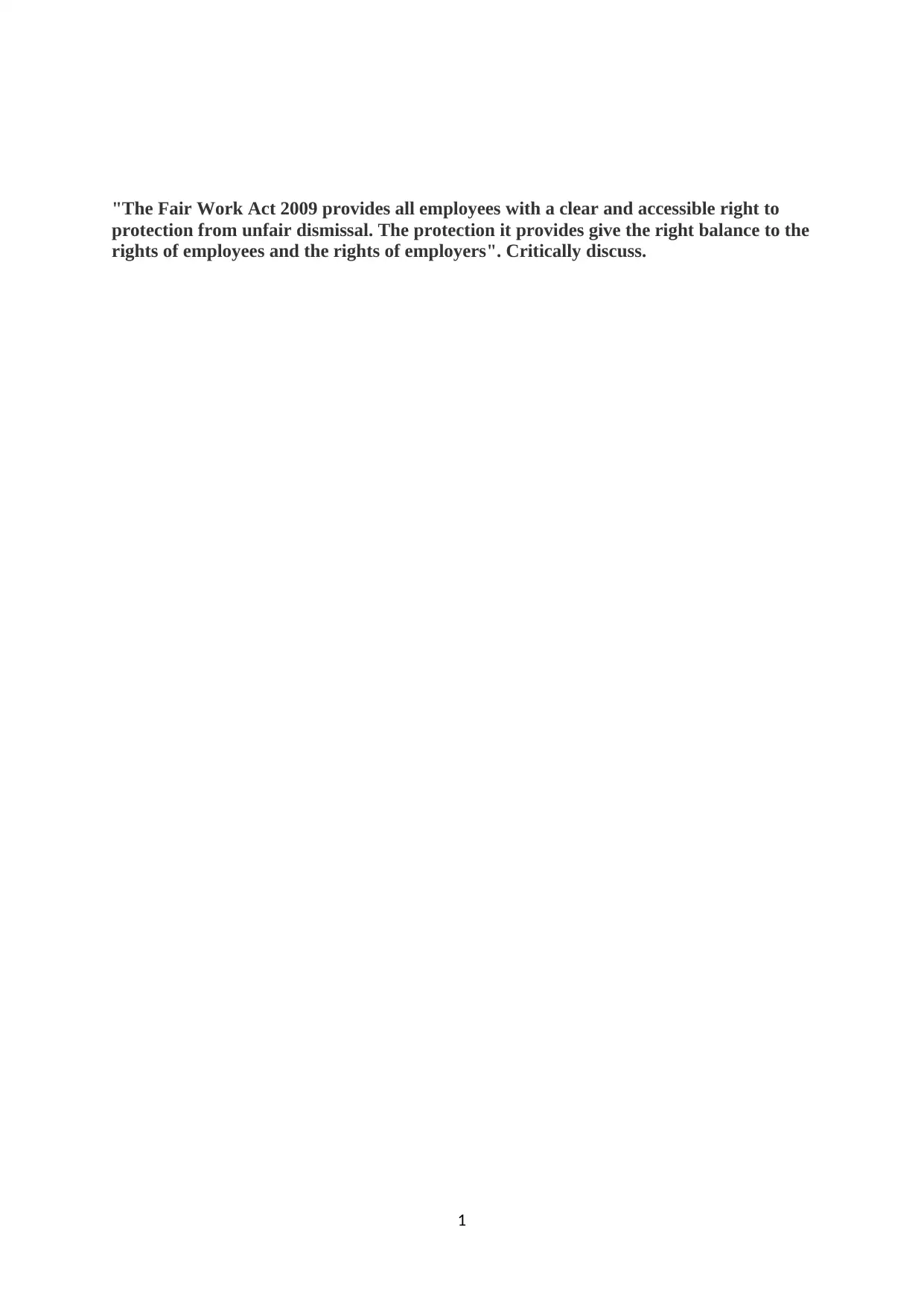
"The Fair Work Act 2009 provides all employees with a clear and accessible right to
protection from unfair dismissal. The protection it provides give the right balance to the
rights of employees and the rights of employers". Critically discuss.
1
protection from unfair dismissal. The protection it provides give the right balance to the
rights of employees and the rights of employers". Critically discuss.
1
Paraphrase This Document
Need a fresh take? Get an instant paraphrase of this document with our AI Paraphraser
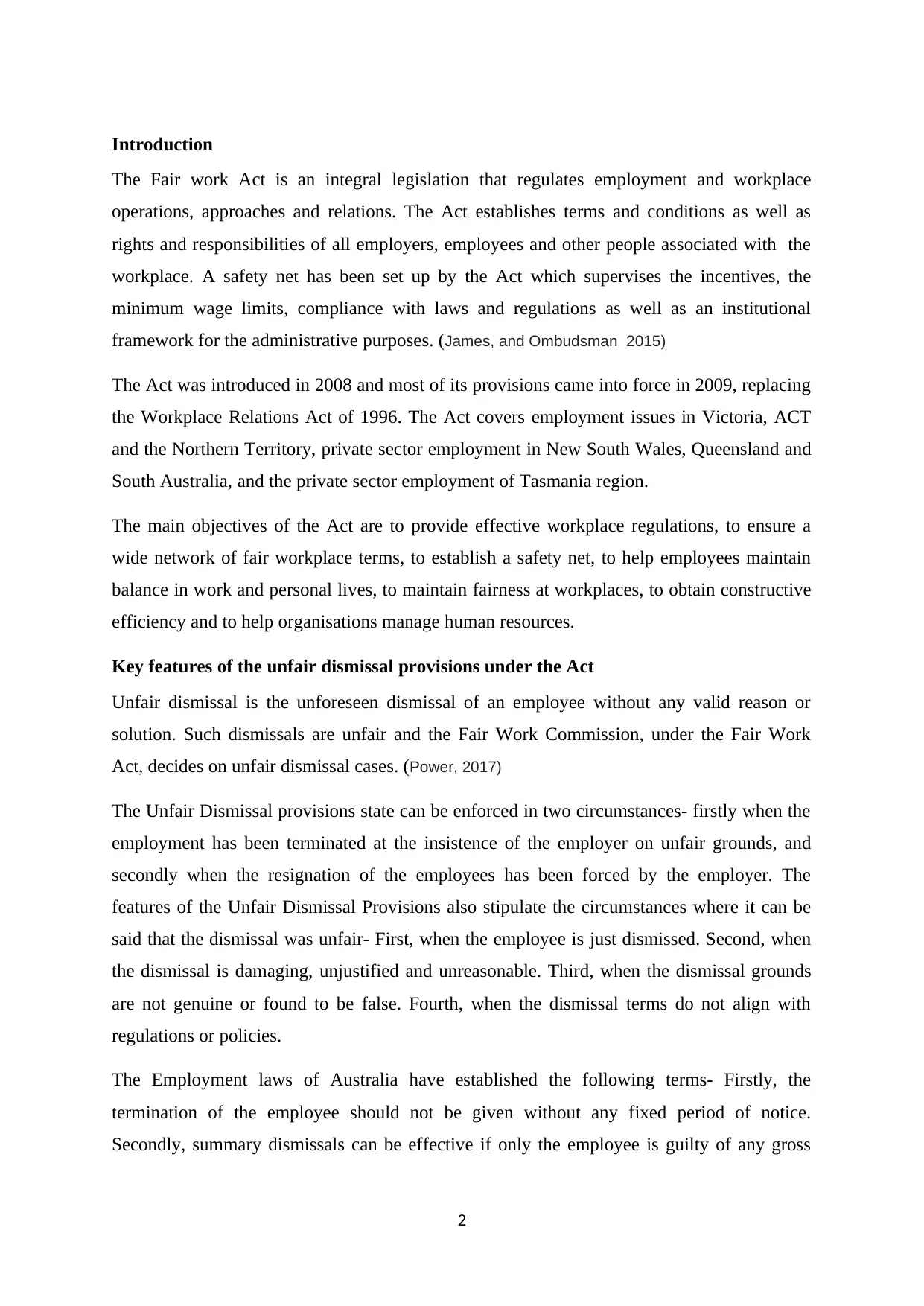
Introduction
The Fair work Act is an integral legislation that regulates employment and workplace
operations, approaches and relations. The Act establishes terms and conditions as well as
rights and responsibilities of all employers, employees and other people associated with the
workplace. A safety net has been set up by the Act which supervises the incentives, the
minimum wage limits, compliance with laws and regulations as well as an institutional
framework for the administrative purposes. (James, and Ombudsman 2015)
The Act was introduced in 2008 and most of its provisions came into force in 2009, replacing
the Workplace Relations Act of 1996. The Act covers employment issues in Victoria, ACT
and the Northern Territory, private sector employment in New South Wales, Queensland and
South Australia, and the private sector employment of Tasmania region.
The main objectives of the Act are to provide effective workplace regulations, to ensure a
wide network of fair workplace terms, to establish a safety net, to help employees maintain
balance in work and personal lives, to maintain fairness at workplaces, to obtain constructive
efficiency and to help organisations manage human resources.
Key features of the unfair dismissal provisions under the Act
Unfair dismissal is the unforeseen dismissal of an employee without any valid reason or
solution. Such dismissals are unfair and the Fair Work Commission, under the Fair Work
Act, decides on unfair dismissal cases. (Power, 2017)
The Unfair Dismissal provisions state can be enforced in two circumstances- firstly when the
employment has been terminated at the insistence of the employer on unfair grounds, and
secondly when the resignation of the employees has been forced by the employer. The
features of the Unfair Dismissal Provisions also stipulate the circumstances where it can be
said that the dismissal was unfair- First, when the employee is just dismissed. Second, when
the dismissal is damaging, unjustified and unreasonable. Third, when the dismissal grounds
are not genuine or found to be false. Fourth, when the dismissal terms do not align with
regulations or policies.
The Employment laws of Australia have established the following terms- Firstly, the
termination of the employee should not be given without any fixed period of notice.
Secondly, summary dismissals can be effective if only the employee is guilty of any gross
2
The Fair work Act is an integral legislation that regulates employment and workplace
operations, approaches and relations. The Act establishes terms and conditions as well as
rights and responsibilities of all employers, employees and other people associated with the
workplace. A safety net has been set up by the Act which supervises the incentives, the
minimum wage limits, compliance with laws and regulations as well as an institutional
framework for the administrative purposes. (James, and Ombudsman 2015)
The Act was introduced in 2008 and most of its provisions came into force in 2009, replacing
the Workplace Relations Act of 1996. The Act covers employment issues in Victoria, ACT
and the Northern Territory, private sector employment in New South Wales, Queensland and
South Australia, and the private sector employment of Tasmania region.
The main objectives of the Act are to provide effective workplace regulations, to ensure a
wide network of fair workplace terms, to establish a safety net, to help employees maintain
balance in work and personal lives, to maintain fairness at workplaces, to obtain constructive
efficiency and to help organisations manage human resources.
Key features of the unfair dismissal provisions under the Act
Unfair dismissal is the unforeseen dismissal of an employee without any valid reason or
solution. Such dismissals are unfair and the Fair Work Commission, under the Fair Work
Act, decides on unfair dismissal cases. (Power, 2017)
The Unfair Dismissal provisions state can be enforced in two circumstances- firstly when the
employment has been terminated at the insistence of the employer on unfair grounds, and
secondly when the resignation of the employees has been forced by the employer. The
features of the Unfair Dismissal Provisions also stipulate the circumstances where it can be
said that the dismissal was unfair- First, when the employee is just dismissed. Second, when
the dismissal is damaging, unjustified and unreasonable. Third, when the dismissal grounds
are not genuine or found to be false. Fourth, when the dismissal terms do not align with
regulations or policies.
The Employment laws of Australia have established the following terms- Firstly, the
termination of the employee should not be given without any fixed period of notice.
Secondly, summary dismissals can be effective if only the employee is guilty of any gross
2
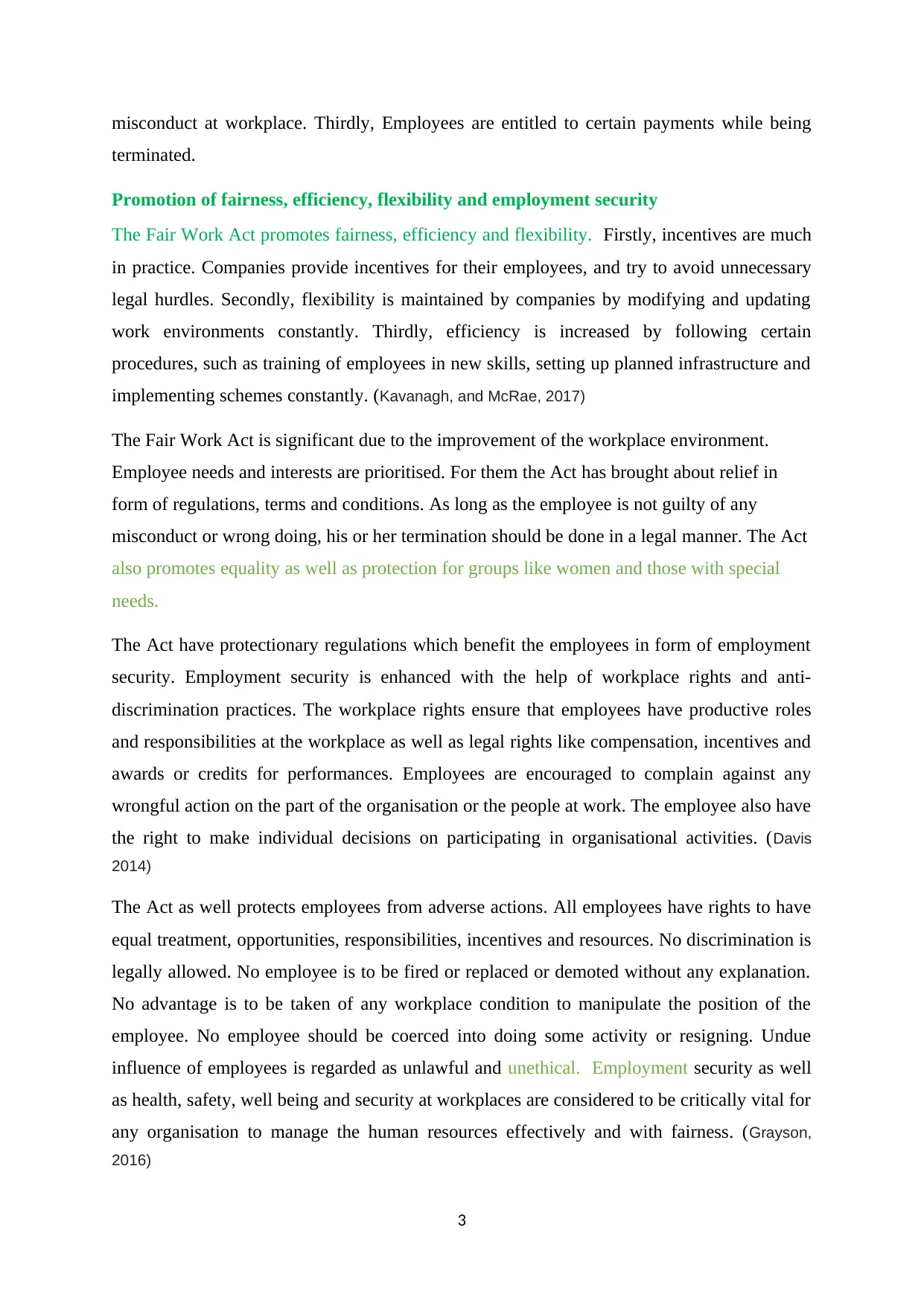
misconduct at workplace. Thirdly, Employees are entitled to certain payments while being
terminated.
Promotion of fairness, efficiency, flexibility and employment security
The Fair Work Act promotes fairness, efficiency and flexibility. Firstly, incentives are much
in practice. Companies provide incentives for their employees, and try to avoid unnecessary
legal hurdles. Secondly, flexibility is maintained by companies by modifying and updating
work environments constantly. Thirdly, efficiency is increased by following certain
procedures, such as training of employees in new skills, setting up planned infrastructure and
implementing schemes constantly. (Kavanagh, and McRae, 2017)
The Fair Work Act is significant due to the improvement of the workplace environment.
Employee needs and interests are prioritised. For them the Act has brought about relief in
form of regulations, terms and conditions. As long as the employee is not guilty of any
misconduct or wrong doing, his or her termination should be done in a legal manner. The Act
also promotes equality as well as protection for groups like women and those with special
needs.
The Act have protectionary regulations which benefit the employees in form of employment
security. Employment security is enhanced with the help of workplace rights and anti-
discrimination practices. The workplace rights ensure that employees have productive roles
and responsibilities at the workplace as well as legal rights like compensation, incentives and
awards or credits for performances. Employees are encouraged to complain against any
wrongful action on the part of the organisation or the people at work. The employee also have
the right to make individual decisions on participating in organisational activities. (Davis
2014)
The Act as well protects employees from adverse actions. All employees have rights to have
equal treatment, opportunities, responsibilities, incentives and resources. No discrimination is
legally allowed. No employee is to be fired or replaced or demoted without any explanation.
No advantage is to be taken of any workplace condition to manipulate the position of the
employee. No employee should be coerced into doing some activity or resigning. Undue
influence of employees is regarded as unlawful and unethical. Employment security as well
as health, safety, well being and security at workplaces are considered to be critically vital for
any organisation to manage the human resources effectively and with fairness. (Grayson,
2016)
3
terminated.
Promotion of fairness, efficiency, flexibility and employment security
The Fair Work Act promotes fairness, efficiency and flexibility. Firstly, incentives are much
in practice. Companies provide incentives for their employees, and try to avoid unnecessary
legal hurdles. Secondly, flexibility is maintained by companies by modifying and updating
work environments constantly. Thirdly, efficiency is increased by following certain
procedures, such as training of employees in new skills, setting up planned infrastructure and
implementing schemes constantly. (Kavanagh, and McRae, 2017)
The Fair Work Act is significant due to the improvement of the workplace environment.
Employee needs and interests are prioritised. For them the Act has brought about relief in
form of regulations, terms and conditions. As long as the employee is not guilty of any
misconduct or wrong doing, his or her termination should be done in a legal manner. The Act
also promotes equality as well as protection for groups like women and those with special
needs.
The Act have protectionary regulations which benefit the employees in form of employment
security. Employment security is enhanced with the help of workplace rights and anti-
discrimination practices. The workplace rights ensure that employees have productive roles
and responsibilities at the workplace as well as legal rights like compensation, incentives and
awards or credits for performances. Employees are encouraged to complain against any
wrongful action on the part of the organisation or the people at work. The employee also have
the right to make individual decisions on participating in organisational activities. (Davis
2014)
The Act as well protects employees from adverse actions. All employees have rights to have
equal treatment, opportunities, responsibilities, incentives and resources. No discrimination is
legally allowed. No employee is to be fired or replaced or demoted without any explanation.
No advantage is to be taken of any workplace condition to manipulate the position of the
employee. No employee should be coerced into doing some activity or resigning. Undue
influence of employees is regarded as unlawful and unethical. Employment security as well
as health, safety, well being and security at workplaces are considered to be critically vital for
any organisation to manage the human resources effectively and with fairness. (Grayson,
2016)
3
⊘ This is a preview!⊘
Do you want full access?
Subscribe today to unlock all pages.

Trusted by 1+ million students worldwide
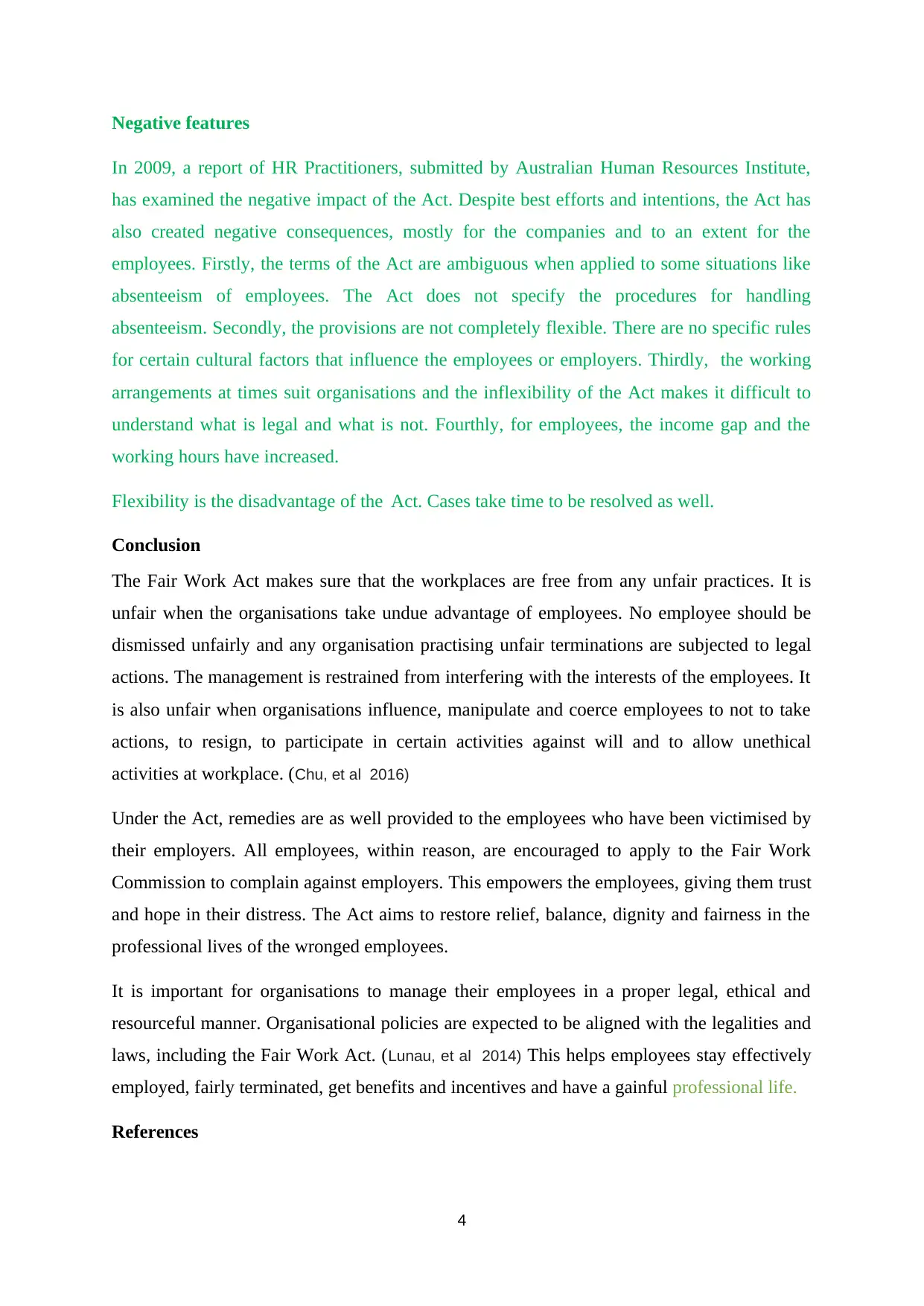
Negative features
In 2009, a report of HR Practitioners, submitted by Australian Human Resources Institute,
has examined the negative impact of the Act. Despite best efforts and intentions, the Act has
also created negative consequences, mostly for the companies and to an extent for the
employees. Firstly, the terms of the Act are ambiguous when applied to some situations like
absenteeism of employees. The Act does not specify the procedures for handling
absenteeism. Secondly, the provisions are not completely flexible. There are no specific rules
for certain cultural factors that influence the employees or employers. Thirdly, the working
arrangements at times suit organisations and the inflexibility of the Act makes it difficult to
understand what is legal and what is not. Fourthly, for employees, the income gap and the
working hours have increased.
Flexibility is the disadvantage of the Act. Cases take time to be resolved as well.
Conclusion
The Fair Work Act makes sure that the workplaces are free from any unfair practices. It is
unfair when the organisations take undue advantage of employees. No employee should be
dismissed unfairly and any organisation practising unfair terminations are subjected to legal
actions. The management is restrained from interfering with the interests of the employees. It
is also unfair when organisations influence, manipulate and coerce employees to not to take
actions, to resign, to participate in certain activities against will and to allow unethical
activities at workplace. (Chu, et al 2016)
Under the Act, remedies are as well provided to the employees who have been victimised by
their employers. All employees, within reason, are encouraged to apply to the Fair Work
Commission to complain against employers. This empowers the employees, giving them trust
and hope in their distress. The Act aims to restore relief, balance, dignity and fairness in the
professional lives of the wronged employees.
It is important for organisations to manage their employees in a proper legal, ethical and
resourceful manner. Organisational policies are expected to be aligned with the legalities and
laws, including the Fair Work Act. (Lunau, et al 2014) This helps employees stay effectively
employed, fairly terminated, get benefits and incentives and have a gainful professional life.
References
4
In 2009, a report of HR Practitioners, submitted by Australian Human Resources Institute,
has examined the negative impact of the Act. Despite best efforts and intentions, the Act has
also created negative consequences, mostly for the companies and to an extent for the
employees. Firstly, the terms of the Act are ambiguous when applied to some situations like
absenteeism of employees. The Act does not specify the procedures for handling
absenteeism. Secondly, the provisions are not completely flexible. There are no specific rules
for certain cultural factors that influence the employees or employers. Thirdly, the working
arrangements at times suit organisations and the inflexibility of the Act makes it difficult to
understand what is legal and what is not. Fourthly, for employees, the income gap and the
working hours have increased.
Flexibility is the disadvantage of the Act. Cases take time to be resolved as well.
Conclusion
The Fair Work Act makes sure that the workplaces are free from any unfair practices. It is
unfair when the organisations take undue advantage of employees. No employee should be
dismissed unfairly and any organisation practising unfair terminations are subjected to legal
actions. The management is restrained from interfering with the interests of the employees. It
is also unfair when organisations influence, manipulate and coerce employees to not to take
actions, to resign, to participate in certain activities against will and to allow unethical
activities at workplace. (Chu, et al 2016)
Under the Act, remedies are as well provided to the employees who have been victimised by
their employers. All employees, within reason, are encouraged to apply to the Fair Work
Commission to complain against employers. This empowers the employees, giving them trust
and hope in their distress. The Act aims to restore relief, balance, dignity and fairness in the
professional lives of the wronged employees.
It is important for organisations to manage their employees in a proper legal, ethical and
resourceful manner. Organisational policies are expected to be aligned with the legalities and
laws, including the Fair Work Act. (Lunau, et al 2014) This helps employees stay effectively
employed, fairly terminated, get benefits and incentives and have a gainful professional life.
References
4
Paraphrase This Document
Need a fresh take? Get an instant paraphrase of this document with our AI Paraphraser
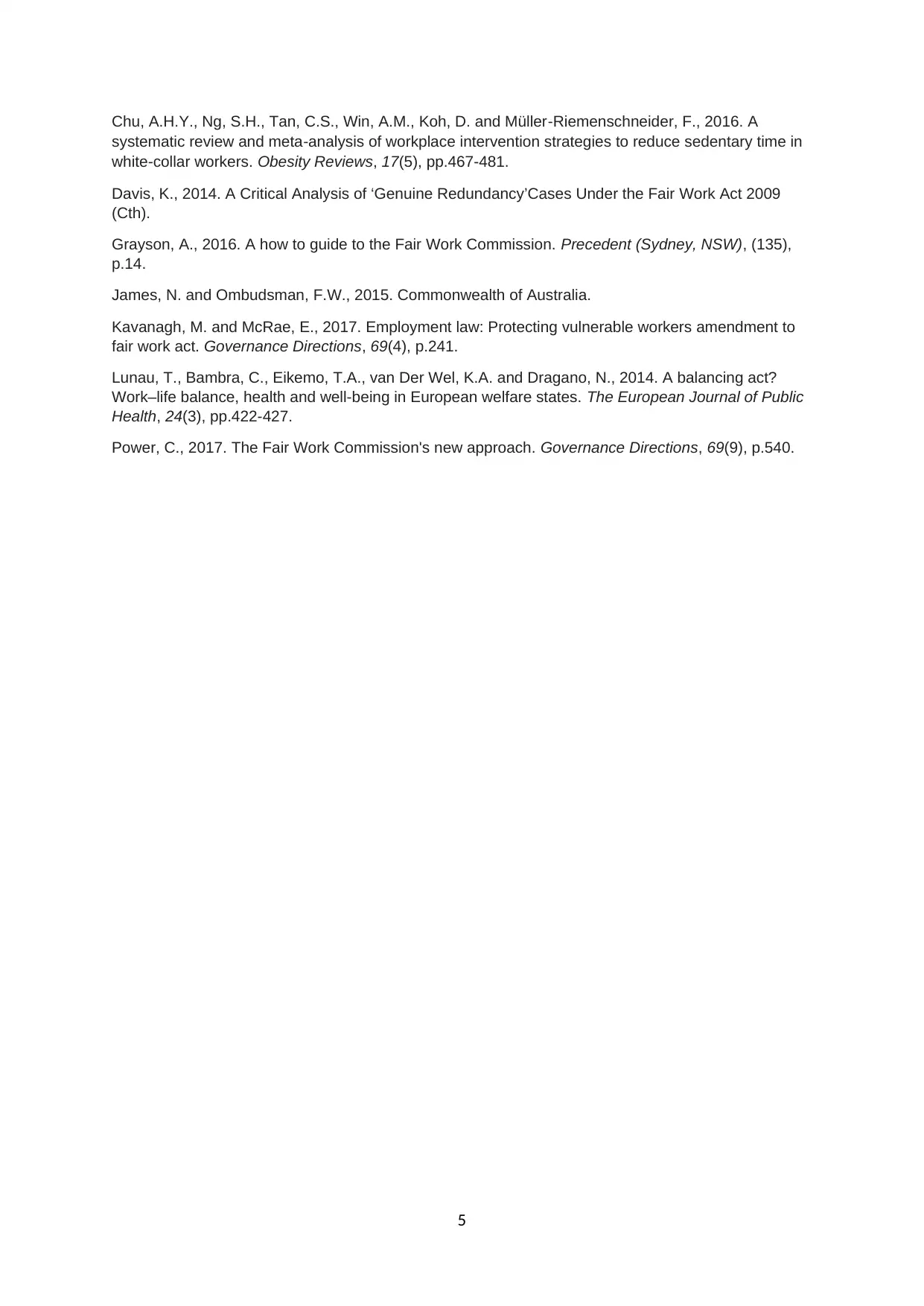
Chu, A.H.Y., Ng, S.H., Tan, C.S., Win, A.M., Koh, D. and Müller‐Riemenschneider, F., 2016. A
systematic review and meta‐analysis of workplace intervention strategies to reduce sedentary time in
white‐collar workers. Obesity Reviews, 17(5), pp.467-481.
Davis, K., 2014. A Critical Analysis of ‘Genuine Redundancy’Cases Under the Fair Work Act 2009
(Cth).
Grayson, A., 2016. A how to guide to the Fair Work Commission. Precedent (Sydney, NSW), (135),
p.14.
James, N. and Ombudsman, F.W., 2015. Commonwealth of Australia.
Kavanagh, M. and McRae, E., 2017. Employment law: Protecting vulnerable workers amendment to
fair work act. Governance Directions, 69(4), p.241.
Lunau, T., Bambra, C., Eikemo, T.A., van Der Wel, K.A. and Dragano, N., 2014. A balancing act?
Work–life balance, health and well-being in European welfare states. The European Journal of Public
Health, 24(3), pp.422-427.
Power, C., 2017. The Fair Work Commission's new approach. Governance Directions, 69(9), p.540.
5
systematic review and meta‐analysis of workplace intervention strategies to reduce sedentary time in
white‐collar workers. Obesity Reviews, 17(5), pp.467-481.
Davis, K., 2014. A Critical Analysis of ‘Genuine Redundancy’Cases Under the Fair Work Act 2009
(Cth).
Grayson, A., 2016. A how to guide to the Fair Work Commission. Precedent (Sydney, NSW), (135),
p.14.
James, N. and Ombudsman, F.W., 2015. Commonwealth of Australia.
Kavanagh, M. and McRae, E., 2017. Employment law: Protecting vulnerable workers amendment to
fair work act. Governance Directions, 69(4), p.241.
Lunau, T., Bambra, C., Eikemo, T.A., van Der Wel, K.A. and Dragano, N., 2014. A balancing act?
Work–life balance, health and well-being in European welfare states. The European Journal of Public
Health, 24(3), pp.422-427.
Power, C., 2017. The Fair Work Commission's new approach. Governance Directions, 69(9), p.540.
5
1 out of 5
Related Documents
Your All-in-One AI-Powered Toolkit for Academic Success.
+13062052269
info@desklib.com
Available 24*7 on WhatsApp / Email
![[object Object]](/_next/static/media/star-bottom.7253800d.svg)
Unlock your academic potential
Copyright © 2020–2025 A2Z Services. All Rights Reserved. Developed and managed by ZUCOL.





